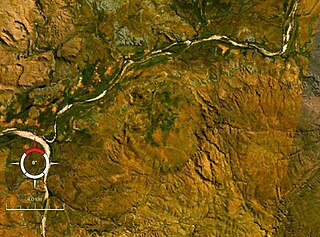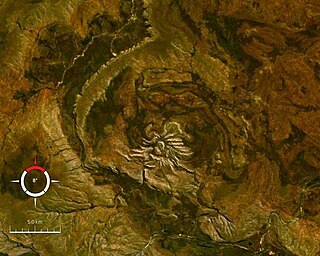 W
WBedout, or more specifically the Bedout High, is a geological and geophysical feature centered about 250 km off the northwestern coast of Australia in the Canning and overlying Roebuck basins. Although not obvious from sea floor topography, it is a roughly circular area about 30 km in diameter where older rocks have been uplifted as much as 4 km towards the surface and may mark the centre of a very large buried impact crater up to 250 km in diameter. The Bedout High was penetrated by two petroleum exploration wells in the 1970s and 1980s. It is named after nearby Bedout Island.
 W
WConnolly Basin is a 9 km-diameter impact crater located in the Gibson Desert of central Western Australia. It lies adjacent to the Talawana Track 45 km west of the junction with the Gary Highway, but is difficult to access due to the remoteness of the area. It was originally thought to be a diapir ; an impact origin was first proposed in 1985.,
 W
WDalgaranga crater is a small meteorite impact crater located on Dalgaranga pastoral station 75 km northwest of Mount Magnet in Western Australia. It is only 24 m in diameter and 3 m deep, making it Australia's smallest impact crater. Though discovered in 1921, it was not reported in the scientific literature until 1938. The bedrock at the site is weathered Archaean granite of the Yilgarn Craton. The discovery of fragments of mesosiderite stony-iron meteorite around the crater confirms an impact origin, making this crater unique as the only one known to have been produced by a mesosiderite projectile.
 W
WGlikson crater is an impact structure, the eroded remnant of a former impact crater, situated in the Little Sandy Desert of central Western Australia. A possible impact structure was first reported in 1997, and named after Australian geologist A. Y. Glikson, attention to the site being drawn by the presence of a prominent 14 km diameter ring-shaped aeromagnetic anomaly. The area within the ring contains sparse outcrop of uplifted and deformed Neoproterozoic sandstone, but is largely covered by sand dunes. The recent discovery of shatter cones and microscopic shock effects is reliable evidence for an impact origin. Deformation of the sandstone consistent with an impact origin extends out to a diameter of 19 km, which is the best estimate for the original diameter of the original crater. The ring-shaped aeromagnetic anomaly was probably caused by disruption of a horizontal layer of magnetic igneous rock, known as a sill, by the impact event. Nearby outcrops of dolerite have been dated at 508 ± 5 Ma (Middle Cambrian), and if this is the same rock causing the aeromagnetic anomaly, then the impact must be younger, probably of Paleozoic age.
 W
WGoat Paddock is a 5 km-diameter near-circular bowl-shaped depression in a range of gently dipping Proterozoic sandstone in the Kimberley Region of northern Western Australia, 106 km west-southwest of Halls Creek. It is interpreted as an ancient meteorite impact crater, the evidence including breccia containing melted rocks, silica glass, shatter cones and shocked quartz. Drilling shows that the crater is filled with about 200 m of ancient lake sediments containing Early Eocene pollen, this age thus giving a minimum estimate for the age of the crater itself. The crater is not perfectly circular, but slightly elongated in a north–south direction, suggesting that the projectile struck at low angle from either the north or south.
 W
WThe Hickman crater is a recently discovered meteorite impact crater, 16 kilometres northeast of the Hope Downs 4 Mine and 35 kilometres north of Newman in the Ophthalmia Range, Western Australia. It was discovered by Arthur Hickman, a government geologist with the Geological Survey of Western Australia, in July 2007. The discovery was made by chance while browsing Google Earth. A 2012 government scientific drilling project in the centre of the crater confirmed in 2017 the impact of an iron-nickel meteorite.
 W
WPiccaninny crater is an impact structure, the eroded remnant of a former impact crater, situated in northern Western Australia in the Kimberley region. It was named after Piccaninny Creek and lies within the Purnululu National Park.
 W
WShoemaker is an impact structure, the deeply eroded remnant of a former impact crater, situated in arid central Western Australia, about 100 km (62 mi) north-northeast of Wiluna. It is named in honour of planetary geologist Eugene Shoemaker.
 W
WSpider is an impact structure, the deeply eroded remnant of a former impact crater, situated in the Kimberley Region of northern Western Australia, 18 km east of the Mount Barnett Roadhouse on the Gibb River Road. Due to very rugged terrain the site is effectively inaccessible. The name is derived from the visually striking spider-like radiating ridges of quartzite prominently visible from the air or on satellite images.
 W
WVeevers crater is an impact crater located on a flat desert plain between the Great Sandy and Gibson Deserts in the center of the state of Western Australia. The site is very remote and difficult to visit. The crater was discovered from the air in July 1975 during a government geological survey and named in honor of Australian geologist John Veevers who had worked in the area in the late 1950s. At the time of discovery a meteorite impact origin was suspected, but could not be proven. The subsequent discovery of iron meteorite fragments around the crater by E.M. and C.S. Shoemaker in 1984 removed any doubt about its origin.
 W
WWolfe Creek Crater is a well-preserved meteorite impact crater (astrobleme) in Western Australia.
 W
WWoodleigh is a large meteorite impact crater (astrobleme) in Western Australia, centred on Woodleigh Station east of Shark Bay, Gascoyne region. A team of four scientists at the Geological Survey of Western Australia and the Australian National University, led by Arthur J. Mory, announced the discovery in the 15 April 2000 issue of Earth and Planetary Science Letters.
 W
WThe Yarrabubba crater is an impact structure, the eroded remnant of a former impact crater, situated in the northern Yilgarn Craton near Yarrabubba Station between the towns of Sandstone and Meekatharra, Mid West Western Australia. With an age of 2.229 billion years, it is one of the oldest known impact structures on Earth.